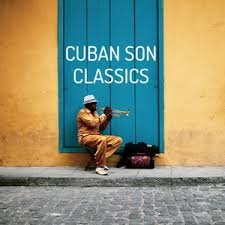Son Cubano
Afro-Cuban music is all about rhythm. *
Son Cubano (the Cuban sound) is a genre at the heart of Cuban music. It developed in eastern Cuba (Oriente) in the late 19th century. Son Cubano is a blend of Spanish and African elements. Spain contributed the vocal style, a moderate tempo, and the tres, a guitar-like instrument with three pairs of strings. From Africa came complex rhythms, particularly the clave rhythm, call-and-response singing, and the percussion instruments typically found in a Son conjunto (group): claves, bongos, maríbulas, congas, güiro, and maracas.
The popularity of Son spread westward, throughout the island and into the big cities, especially Havana and Matanzas. From the big cities, Son Cubano jumped to New York and around the world. It played a role in the music of bands such as Duke Ellington’s and Dizzy Gillespie’s.
In Havana, the 1930s was a golden era for Son Cubano. Formally structured sextets, septets, and big bands played Son Cubano with typical instrumentation: piano, guitar or tres, trumpet, double bass, congas, bongos, timbales, claves, and guiro. The songs also had a typical, two-part structure. A song begins with a largo section of descriptive lyrics sung by a sonero, the lead singer, in a “suave, bel canto style.” ** The largo is followed by a longer montuno section. The montuno features harmonic call-and-response sung by a chorus in an extended ostinado. The clave rhythm anchors both sections.
“. . . the most important aspect and the defining characteristic of all Afro-Cuban music is the rhythm.” *
When a gringo like me first sees a Latin conjunto perform, the gringo is likely to see half a dozen musicians banging or scraping on gourds, wooden sticks, or small drums. Why so many? They look like dead weight, something to occupy the singers' hands. Not so! Each instrument plays a different rhythm, and therein lies the complexity and needed skill. All the rhythms must blend seamlessly into a rhythmic whole. The instrument that looks the simplest, even silly to gringo eyes, is two wooden sticks that are struck together. The playing of sticks, called claves, creates the rhythmic structure that anchors a song.
The most important Afro-Cuban rhythm is clave, an essential part of Son Cubano. The clave is one of several different rhythms played in the same song, each on a different instrument. Each instrument plays its rhythm throughout the song with little or no change. Clave is the foundation rhythm upon which all the others are built. All the rhythms fit together like pieces of a puzzle to produce a danceable, “. . . nice, tight groove.” *
Clave is a syncopated rhythm. Once you hear it, it is easy to recognize. My understanding of music theory is razor thin, so instead of trying to explain clave, I’ll point you to a video that explains clave and to a few music videos.
Here is an explanation of clave: The World’s Most Popular Rhythm. For more on Afro-Cuban rhythm: Afro-Cuban Jazz Explained.
These are music videos within which you can hear clave. Listen to the wooden sticks.
“Vida Parrandera”, [The Party Life Is Killing Me] La Familia Valera Miranda
“Vamos A Bailar Un Son”, [Let’s Dance a Son] Eliades Ochoa, my favorite guitarist
Clave, both the instrument and the rhythm, are ancient, probably originating in Africa. The rhythm is found in many genres and is one of the most important rhythms in the world. “It is the most important aspect and the defining characteristic of all Afro-Cuban music.”*
One of the direct descendants of Son Cubano is Salsa, a dance music genre that has endured as a worldwide dance music for decades. Son Cubano itself has gone through several waves of popularity. Groups such as Sierra Maestra and Los Van Van set out to revive Son Cubano. Ry Cooder produced the album Buena Vista Social Club, which led to a renewed interest in Son Cubano and some of the elder statesmen and women of Son Cubano who were supposedly forgotten, cruelly buried by Cuba’s communist regime. I would later learn that, contrary to what Cooder’s album implied, the Castro government encouraged the development of indigenous Cuban culture. The music was never buried.
*Walk That Base, “Afro-Cuban Jazz Explained”, Youtube, uploaded by Walk That Base, July 14, 2017, https://youtu.be/8BShjpnliKc?si=HRM7nk1nAeX7Kbwl
**Manuel, Peter, “Caribbean Currents: Caribbean Music from Rumba to Reggae, Revised Edition”, Chapter 2, “Cuba”, 2006
